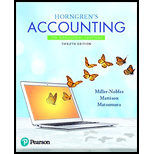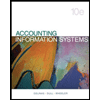
1. With good internal controls, the person who handles cash can also
| Learning Objective 1 |
- account for cash payments.
- account for cash receipts from customers.
- issue credits to customers for sales returns.
- None of the above
Internal Control: Internal controls are just approaches or methods set up to defend a benefit, give solid budgetary data, advance productive and successful operations, and guarantee strategy consistence. For instance: When you came to work toward the beginning of today did you bolt the ways to your home? Provided that this is true, that is a case of an "internal control" you used to ensure the advantages you claim.
What other work can a person handling cash can do if the organization has good internal controls.
Explanation of Solution
Solution: option d
Good internal controls mean that the organization is working efficiently and effectively by adhering to the company policies and procedures. It also ensures that proper controls are in place to ensure that no task is distributed to counter or to affect the independence and integrity of work performed by one person.
Definition of internal control contains the following parts:
a. Safeguarding of assets
b. Encourage employees to follow company policies.
c. Promote Operational efficiencies
d. Compliance with applicable laws and regulations.
Explanations:
If a person is handling cash a good internal control requires that proper separation of duties should be in place to ensure a single person should not have the total control over the entire cash process.
Given options can be analyzed as follows:
- A person handling the cash should not account for cash payment as it is a part of an effective internal control and comes under separation of duties.
- If the person handling the cash accounts for cash receipts then there may be chances that the cashier my enter wrong amounts in accounts making the internal control process inefficient, hence this option is also incorrect.
- Issuing credits to customer for sales returns also is a responsibility which need to be segregated from the person handling the responsibility of cash this option is incorrect.
- None of the above is a right choice as none of the option is correct.
From the above analysis, we can conclude that all the responsibilities will make the internal controls weak hence its not advisable to so any of the given task hence option d is correct.
Want to see more full solutions like this?
Chapter 9 Solutions
Horngren's Accounting (12th Edition)
Additional Business Textbook Solutions
Intermediate Accounting (2nd Edition)
Financial Accounting, Student Value Edition (5th Edition)
Horngren's Cost Accounting: A Managerial Emphasis (16th Edition)
Gitman: Principl Manageri Finance_15 (15th Edition) (What's New in Finance)
Principles of Operations Management: Sustainability and Supply Chain Management (10th Edition)
Corporate Finance (4th Edition) (Pearson Series in Finance) - Standalone book
 Auditing: A Risk Based-Approach (MindTap Course L...AccountingISBN:9781337619455Author:Karla M Johnstone, Audrey A. Gramling, Larry E. RittenbergPublisher:Cengage Learning
Auditing: A Risk Based-Approach (MindTap Course L...AccountingISBN:9781337619455Author:Karla M Johnstone, Audrey A. Gramling, Larry E. RittenbergPublisher:Cengage Learning College Accounting (Book Only): A Career ApproachAccountingISBN:9781337280570Author:Scott, Cathy J.Publisher:South-Western College PubPrinciples of Accounting Volume 1AccountingISBN:9781947172685Author:OpenStaxPublisher:OpenStax College
College Accounting (Book Only): A Career ApproachAccountingISBN:9781337280570Author:Scott, Cathy J.Publisher:South-Western College PubPrinciples of Accounting Volume 1AccountingISBN:9781947172685Author:OpenStaxPublisher:OpenStax College Auditing: A Risk Based-Approach to Conducting a Q...AccountingISBN:9781305080577Author:Karla M Johnstone, Audrey A. Gramling, Larry E. RittenbergPublisher:South-Western College Pub
Auditing: A Risk Based-Approach to Conducting a Q...AccountingISBN:9781305080577Author:Karla M Johnstone, Audrey A. Gramling, Larry E. RittenbergPublisher:South-Western College Pub Pkg Acc Infor Systems MS VISIO CDFinanceISBN:9781133935940Author:Ulric J. GelinasPublisher:CENGAGE L
Pkg Acc Infor Systems MS VISIO CDFinanceISBN:9781133935940Author:Ulric J. GelinasPublisher:CENGAGE L




